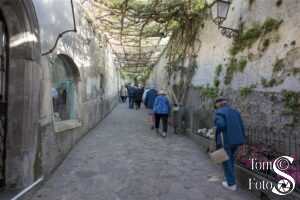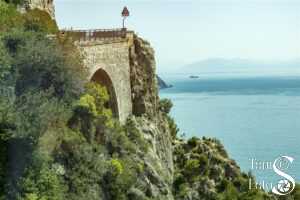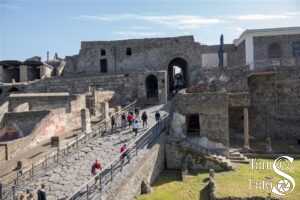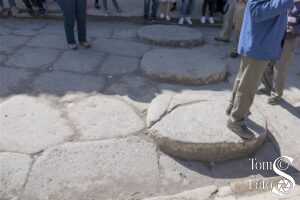Positano is a tender port as there is no dock able to handle a cruise ship; indeed, it barely handles the tender. The town is built on the side of a mountain jutting a couple of thousand feet out of the sea about half way between Sicily and Rome in Italy. The town is so steep and compact that the lower part bans all motorized vehicles as they just won’t fit.
You can imagine what that means…that’s right, walking uphill until you get to the part where cars can drive. We were told it would be a 15 minute walk up a gentle slope to the minibus that would take us to Pompeii. HAH! That time is a bit short and gentle is not a word that could be applied to the combination of steps and slopes we had to navigate. Everyone was huffing and puffing at the end of the walk (photo one). I imagine the locals who have to do this every day were snickering as we passed by but I was concentrating on keeping my balance and keeping up with the guide — or at least keeping him in sight. (I’ve discovered that I like stairs that have rails to hold onto much better than stairs alone even with a walking stick which I used today.)
We got on our bus and recovered while the driver took over getting us the rest of the way. The road was one of those etched into the side of a cliff; the kind you see car chases on in the movies (photo two). When we got out of town there were cars parked all along the road; mostly on the cliff side. I asked why all the cars and was told that those were cars for residents of the town who have no garage. There is no parking on the streets in town so if you don’t have a garage or space to pull into you can’t keep your car in town. So, the residents park along the road above and have to walk to and from their car and that walk is much longer than the one we did.
The drive to Pompeii is about an hour and a half and a good half of that is on the type of road shown above. Then, we suddenly entered a tunnel that turned out to be about three miles long and exited on the other side of the mountain into the city of Sorrento. Pompeii is on the other side of Sorrento and we made our way over local (narrow) streets and a toll motorway.
Pompeii was not exactly what I expected. When I see illustrations I usually see large areas of scorched earth so I expected to do a fair amount of walking to get a glimpse of the city, or at least the portion of the city that has been recovered. Not so much. The Pompeii I saw was a compact city sitting at the time right on the coast. We even were able to see the rings that boats tied up to when the city was a thriving metropolis. You also often think about lava covering the city. Also, not true. What covered the city was about 30 feet (that’s right, feet) of volcanic ash. That ash not only covered the city but built a fair amount of land between the city and the ocean that is now several miles from the city gate. The city was forgotten.
Some farmers rediscovered the city while digging wells for water. It was war-time and soldiers came and dug out some areas looking for things that could be used for making weapons and when they found nothing of use for that purpose they just covered things over again. Only later did the city become an archaeological site.
We walked in via the sea gate (up of course like everything else in Italy — photo three) to the main thoroughfare. Our guide took us around the area that is set aside for tourists. It was interesting to see the daily life indicators in the city that had been uncovered. As one example, most streets had high curbs. Why? They were used as both streets and open sewers. The high curbs allowed people to walk without being splashed as various vehicles went through the muck. There were even grooves in the rocks lining the streets showing the wheel markings carved out due to constant use. And, Pompeii had speed bumps for traffic control! At various points along the roads you would see a few rocks set into the streets. These were used to slow vehicles (carriages) down and were also used by pedestrians crossing the streets (photo four).
Now, it might have seemed gross when I mentioned the streets were also on open sewer but the Romans had a cure for that as well. Throughout the city were a considerable number of public fountains; really nothing more than a large holding tank with a decorated spout above. Each fountain was used for drinking and also had a small plug of lead at its bottom. Several times a day a signal would go out and workers at all the fountains would pull the plugs; all at the same time. This flood of water moved into the streets and washed them. So, the sewer was washed a few times a day and the streets stayed at least reasonably clean.
There is more that you will see in other photos in the talk I plan. After seeing Pompeii we returned via the road we took to get there. The walk down from the bus parking area was much easier than the one going up and I stopped at times to get some shots of Positano and particularly the church. Like many, the church in Positano is unassuming on the outside but quite striking on the inside.
Speaking of the talk, I suspect that the Photo Club talks will be fairly broad overviews of this trip and that there will be other talks, maybe in other venues, that go into more detail about certain areas I choose to discuss. As an example, for the Pacific Ocean section I’ve set aside some 876 photos. No way I can do those in one hour.
Also, I may have to change the schedule after September from what I’ve discussed before (July = Pacific Ocean, August = Indian Ocean, etc.). Princess has a 60-day cruise of the North Pacific that is Los Angeles to Los Angeles. It goes north from LA to Alaska and then over to Asia to touch China, Japan, Viet Nam and other countries and cities. It comes back straight across the Pacific via Guam and Hawaii to LA. There is a real possibility that I will be on that trip. I have until 6 July to decide for certain and my deposit become non-refundable. They likely won’t be offering this trip in 2019 as it is an experimental itinerary (they have visited all the places but just not put them all together into a single trip). The trip starts 19 September and ends the middle of November. [Added: I did sign up. See here.]
Surprise!



